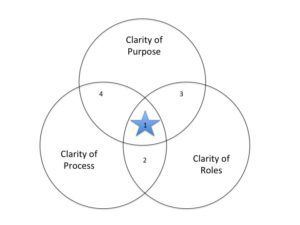Few truly appreciate the astounding benefits of greater clarity or even recognize the lack of clarity that offers so much opportunity. Those who do are using it to beat the competition.

What exactly am I talking about? Greater clarity means:
- Greater specificity of desired outcomes
- Intentionality of process, and
- Proper alignment of responsibility
Every minute of every day.
Clarity allows people to be outcome-focused, action-oriented, and aligned. The benefits are far-ranging:
- Individual and organizational productivity are strong.
- The vast majority of time and energy is dedicated to creating value of which customers are willing to pay.
- Decisions are made by people close to the action without unnecessary approvals and discussion.
- There is less talk and writing, but more communication.
- Meetings accomplish twice as much in half the time.
- Emails are short, productive, used at the right time, and don’t suck up hours of every day.
- Conflict is minimal and healthy debate is plentiful.
- Engagement and commitment are the norm.
Let’s look one at a time at the three components: clarity of purpose, process, and roles.
1. Uncommon Clarity
Region #1 on the diagram is where you want to be. In the center of the Venn diagram where clarity of purpose, process, and roles converge.
What does is look like when you are weak in one or more of the three areas?
2. Rube Goldberg machine
Region #2 lacks a clear purpose. If you don’t have a clear purpose, you don’t really know what you are trying to accomplish. Consequently, you don’t make progress!
I’m not talking about your purpose as an organization. I’m talking about what you are trying to accomplish right now. And an hour from now. What does “done” look like? What identifiable outcome would signify progress? Talk, activity, and effort may feel like progress, but real progress is measured in tangible outcomes. Outcomes such as decisions and plans, as well as more obvious business outcomes such as sales and shipments.
Clarity of purpose increases productivity and improves results. That should seem obvious. What most people don’t realize is how little clarity of purpose exists minute to minute and hour to hour. Whether working alone at a desk, in formal meetings, receiving requests from others, or sending emails, there is often little clarity of purpose, little specificity. Just a general sense of the goal. And the farther from the “production line,” the less clarity there is. A machine operator knows exactly what “done” looks like. How often can you say the same?
Specifying all outcomes with greater clarity will create tremendous benefits for you and those around you.(For more detail, see Want Results? Speak The Language Of Outcomes.)
3. Earnest Inefficiency
Region #3 is lacking a clear process. If you don’t have a clear path, you are wandering. You can’t dispute that statement. This is true whether you are sitting alone at your desk or in a meeting. It is true whether you are working on a big project or a small request dropped in your lap this morning. It is especially true when you are working with others. Earnest Inefficiency is characterized by over-doing, under-doing, wandering around, lots of talking, and generally taking a circuitous path to outcomes instead of making clear, discernible progress. You can be sure that machine operator I mentioned is following a clear process. And you can too. You don’t have to be making widgets to have a process.
How? If you really understand how to create clarity of purpose, it is easy to create clarity of process.
Why? Because a process is nothing more than a sequence of intermediate outcomes that lead to your desired final outcomes. If you pause before jumping in, establish that sequence, you can straighten the winding path and put an end to wandering.
For common activities, such as decision-making, you absolutely should have a clearly understood process to keep everyone on the same page and maximize effectiveness. (To “SOAR through decisions,” read The Most Used Process in Your Company is Also the Most Abused.)
4. Disempowerment
Region #4 lacks clear roles. Clarity of roles includes assigning responsibilities, but it is so much more. It also requires establishing appropriate sense of ownership and commitment, and ensuring that responsibility is not separated from authority. You want the right people making the right decisions without being dragged down by a hierarchy of approvals and processes. Clarity of roles helps everyone grow, develop self-awareness, take responsibility, and act like true partners. (12 Reasons Why How You Make Decisions Is More Important Than What You Decide, is particularly relevant to this topic.)
As for the remaining regions of the diagram, I hope you are not dwelling in any of them.
Specificity creates clarity and clarity creates speed. And that is just the beginning. Embark on a journey to clarity today and you can beat the competition.
![]()
This article originally appeared on Forbes.com on August 28th, 2016.


[…] This Could Be YOUR Competitive Edge […]